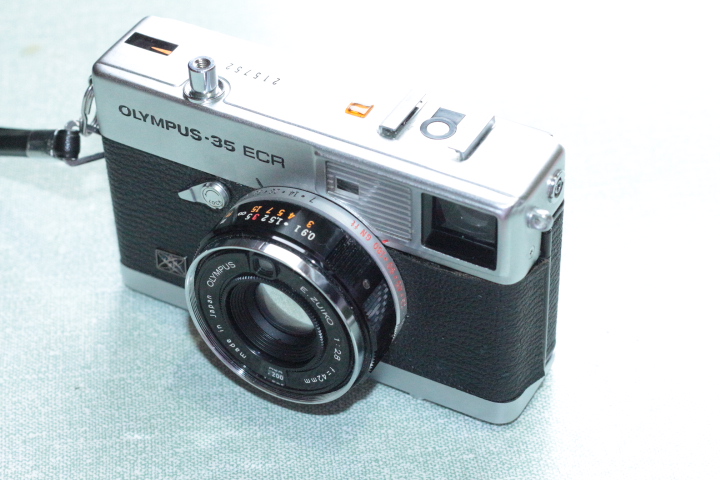This is a small, compact 35mm camera from Olympus. It is a part of the Olympus 35 line - 12 models with varying complexity. This model came out in 1972 and was produced for two years (as far as I can gather).
 |
| Olympus ECR, front view (C) John Margetts |
lens: E. Zuiko
focal length: 42 mm
apertures: f/2.8 automatic
focus range: 3 feet to infinity
lens fitting: fixed
shutter: Seiko ESF
speeds: 4 seconds to 1/800 seconds
flash: hot shoe + PC socket
film size: 35 mm
 |
| Olympus 35 ECR, rear view (C) John Margetts |
First, a description. The camera measures 110 mm wide, 75 mm high and 30 mm deep, not counting the lens, or 50 mm deep, counting the lens. It weighs 450g including a 24 exposure film. The top plate is sparse. On the right is the frame counter. this is reset to 'S' when the back is opened and counts up from zero. 30 mm in from the end of the camera is the shutter release. This is a chrome button and is threaded for a standard cable release - a conical thread to make fitting easier. Just behind the shutter release is the camera serial number. My camera has the number 215752.
Incidentally, to date Olympus cameras (Olympus Trips and Olympus 35 ECR, at least) you take out the film pressure plate and look on the reverse. There are three characters printed on the metal. The first character is a code for the factory where the camera was assembled, the second character is a year number and the third character is a month code. Months run from 1 to 9 for January to September and then X,Y and Z for the last three months. The code on the pressure plate of my ECR is X2Z. (I cannot type the Japanese character in the first position so 'X' instead)) The 2Z signifies the camera was made in year 2 (i.e. 1972) and month Z (i.e. December).
Just to the left of the mid-point is a square orange light. This lights up when the shutter release is pressed part way. This indicates that the battery is good and the camera is ready to use. It does not indicate that the exposure is good as it still lights if the light sensor is covered. Next to this is the accessory shoe. This is a hot shoe and allows for automatic flash use - more later. On the end of the top plate is a PC socket. using this does not to invoke the automatic flash system.
The front of the camera has an anodised aluminium strip (the front of the top plate). On the left this bears the legend "OLYMPUS 35 ECR". to the right are the small rangefinder window (5 x 3 mm) and the larger viewfinder window (12 x 8 mm). The lens/shutter housing is almost central. This houses the Seiko ESF electronic leaf shutter. The lens itself is an E Zuiko lens. The 'E' designation indicates five glass elements (A=1, B=2, C=3, D=4, E=5 etc.). this is a multi-coated lens with a definite blu tinge. Above the lens is the small light meter sensor - a CdS sensor - and below the lens is a window showing the selected film speed. This is marked in ASA but that is essentially the same as ISO. Just around the lens is a serrated ring which turns to select the film speed.
 |
| Olympus ECR bottom view |
The lens takes 43.5 mm filters which cover the light meter sensor as well as the lens so no exposure correction is required for any filter being used. Around the shutter housing is the focusing ring which has a fairly short throw of about 15 degrees and focusses from 0.91 m (3 feet) to infinity. The scale is marked in both metres and feet but that is really academic as the focus ring is connected to the rangefinder and there is no need to look at the scale. The spot in the rangefinder is green and quite visible making the camera quick and easy to focus.
Between the focussing ring and the body is another ring to set the guide number of the flash being used. This has two scales - one in metres (black) and one in feet (red) - which scale you use depends on the guide number given by the flash gun maker. To the left of the lens/shutter housing is a small horizontal lever marked 'LOCK'. Pushing this down locks both the shutter to prevent accidental shots and also switches off the light meter to preserve the batteries.
Just about all 35mm cameras of this age use foam seals to prevent light coming in around the join of the back. As with most 35mm cameras of this age, the light seals have deteriorated and, in fact, have almost disappeared. These will need replacing before the camera can be used - quite a simple job with the foam being available on the Interweb. When this is done, I will run a terst film through the camera and post the results here.



No comments:
Post a Comment